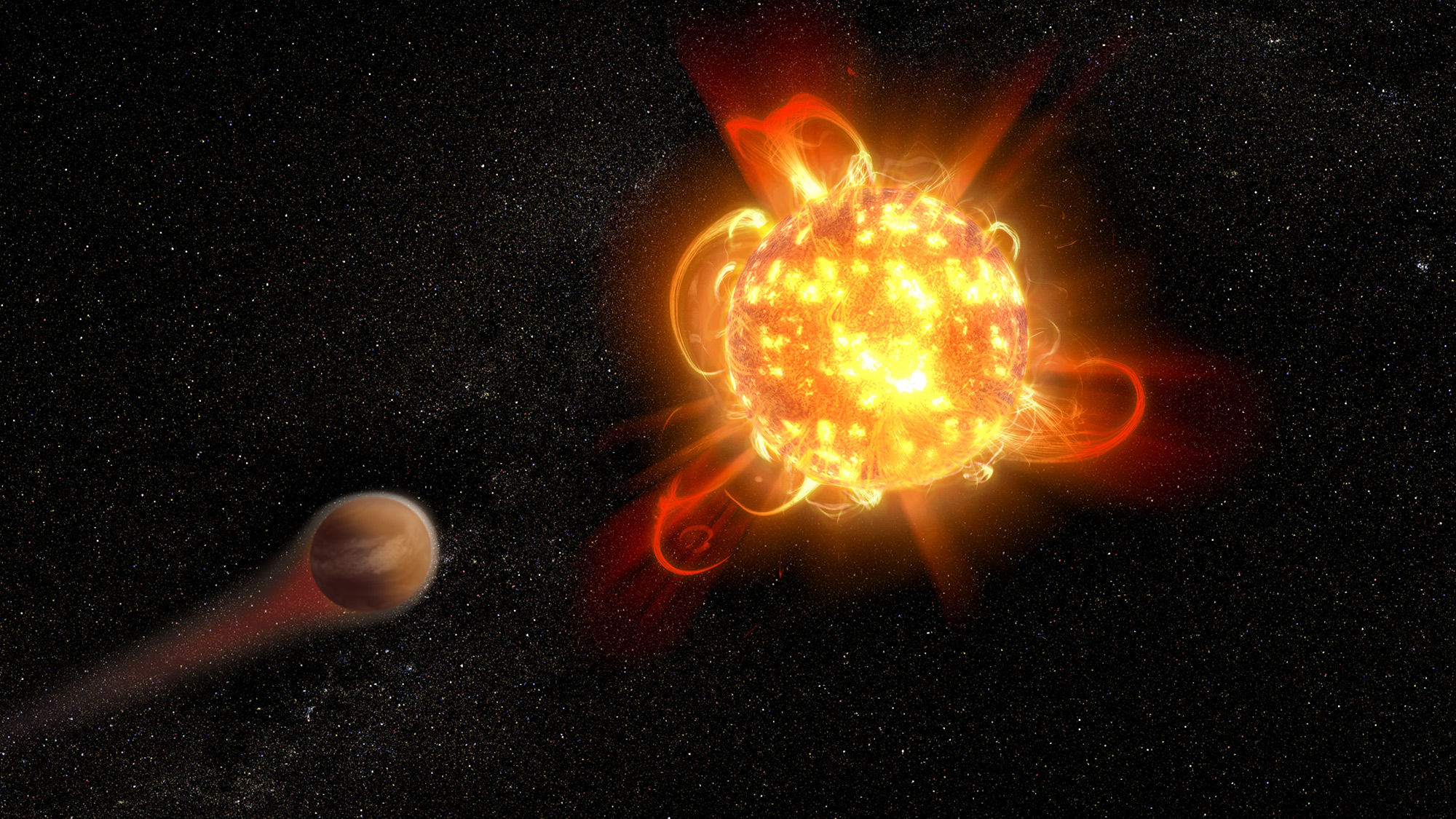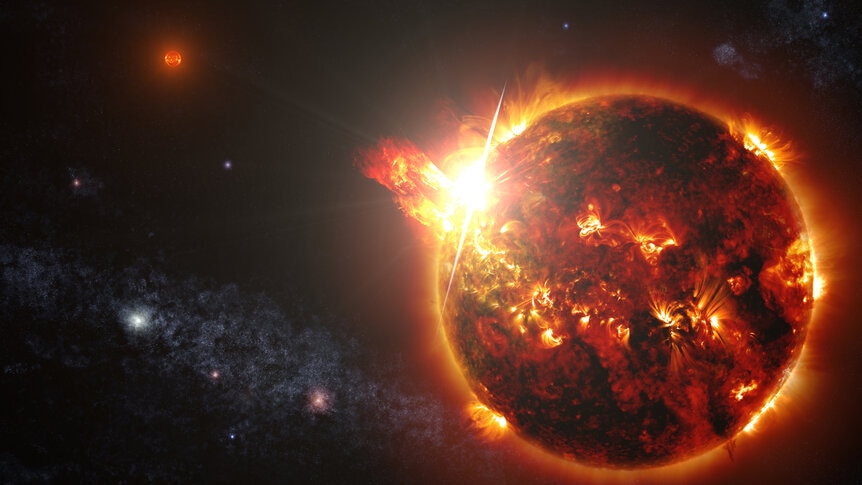Create a free profile to get unlimited access to exclusive videos, sweepstakes, and more!
Young red dwarfs throw mean tantrums. A lot.

Red dwarf stars dominate the galaxy by number; they account for something like 75% of all stars in the Milky Way. Yet for all that, even the nearest one is so faint you need a telescope to spot it at all. They’re dim bulbs; lower mass, cooler, redder, and emitting far less light than the Sun does.
But don’t underestimate them. When red dwarfs get mad, they get really mad. Like, explosively so.
They are renowned for flaring, releasing sudden blasts of energy. Many times these flares are so powerful they can outshine the rest of the star! But even the smaller flares are extraordinary, in that red dwarfs flare a lot, multiple times per day.
The flares are explosive releases of pent-up magnetic energy. Gas inside the star is very hot, hot enough that the hydrogen atoms lose an electron (we say the atoms are ionized, and the gas is then a plasma). Also, hot plasma rises and cool plasma sinks (that’s convection, just like when you boil water), so this material moves up and down in the star, circulating like thousands of towering conveyor belts. One of the most basic rules in physics is that if you move a charged particle it creates a magnetic field. Each one of these convection towers generates its own magnetic field, and as the star spins each interacts and tangles up with the ones around it. Huge amounts of energy get stored in these fields, and, like a sack full of mousetraps, if one snaps and releases its energy the ones around it do, too. This triggers a cascade that creates a vast and sudden release of that energy: a flare.
Red dwarfs are fully convective, meaning the plasma in the entire star, from the core to the surface, moves around this way. That makes them powerful generators of magnetic energy indeed. As it happens, young stars spin faster, too (they slow with age), so they have a stronger magnetic field, and therefore should flare more than older stars. But how much more often? And are the flares from young red dwarfs more powerful than from older ones?
To answer this, a team of astronomers used Hubble Space Telescope to look at a dozen nearby young red dwarfs, monitoring them for flares. They did this by looking in the ultraviolet part of the spectrum, where flares give off the most light (and the stars normally don’t, since they’re red, increasing the contrast). They chose targets known to be part of a loose collection of nearby stars called the Tucana-Horologium group, which all formed together about 40 million years ago. That’s young enough to be active, but old enough that any leftover gas and dust from their formation — which could interfere with the observations — should be long gone.
What they found was pretty amazing: Not only do they flare more often than older stars, the flares are more powerful, too. A lot more.
In general, they found that flares with more than 1030 ergs of energy (totaled over the entire duration of the flare; the Sun emits 4 x 1033 ergs per second, for comparison) happen between 20–100 times more frequently in the observed stars than older red dwarfs.
What about how energetic they are? There are a lot of ways to look at that. It’s a safe bet that smaller flares happen more often than big ones, so you can ask, what’s the typical energy of a flare that happens, say, five times per day? That way you can compare older, quieter stars to younger ones. I’d expect younger ones to flare more powerfully, but by how much?
Looking at their data, they found that for flares of that frequency, the young red dwarfs erupt with 100–1,000 times as much energy as older red dwarfs.
Ye. Gads. Young red dwarfs are feisty.
And one of the stars, called J02365171-5203036 (really just its coordinates on the sky; handy for IDing stars when there are a lot of them), emitted a superflare: During the observations it blew off a flare with a total energy of a whopping 3 x 1033 ergs! That’s a big flare. At one point during the three-minute flare the star shone in ultraviolet light 60 times brighter than when it was quiet.
I have to note at this point that this is happening all the dang time with these stars. These were not long observations: Ten of the stars were observed for a total of between 15 and 30 minutes, and two of them (including J02365) were observed for about three hours. Yet they saw 18 flares in total from the 12 stars, including the superflare. In only ten hours of total observing time! So that’s roughly one flare per star per hour.
As you can imagine, that means being on a planet orbiting one of these kinds of stars wouldn’t be too much fun. Mind you, these are young stars, so it’s not like they’ll have life on planets around them, but 40 million years is plenty of time for a planet like Earth to form around a red dwarf and make itself an atmosphere. However, the flares would profoundly affect it. They can heat a planet’s atmosphere substantially and also sandblast it with a stream of high-speed subatomic particles. Over the course of a few hundred million years one of these stars would flare so much it could literally strip away the atmosphere of a planet!
Does that actually happen? It’s hard to say. As they age red dwarfs simmer down and flare less often, so it’s possible a planet could make it through the star’s toddler tantrum stage. Also, while the UV onslaught of a flare can do damage like break down ozone, it can also rip apart organic (carbon-based) molecules, which then rebuild themselves into complex structures that would make a haze layer in the planet’s air. Ironically that can protect the surface from UV light (we see this happening in our own solar system; Saturn’s moon Titan has a thick haze layer from this process).
In the end it’s hard to say how this might affect habitability of planets around red dwarfs. That’s too bad; this is something I’d dearly love to know. Red dwarfs are really good at making planets (just look at TRAPPIST-1 with seven Earth-sized planets orbiting it!), and when you couple that with how common red dwarfs are, that means these kinds of planets might outnumber all other planets in the galaxy combined.
The more we look out into the sky, the more we see how different everything is from what we’re used to here on Earth, orbiting our Sun. In many ways, we’re the exception, and by studying these little red stars we’re trying to figure out how most of the Universe behaves.
That strikes me as a pretty good idea.




























